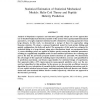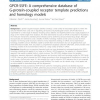258 search results - page 33 / 52 » Multiobjectivizing the HP Model for Protein Structure Predic... |
CORR
2010
Springer
13 years 7 months ago
2010
Springer
Abstract. The paper investigates a novel approach, based on Constraint Logic Programming (CLP), to predict the 3D conformation of a protein via fragments assembly. The fragments ar...
JCB
2007
13 years 7 months ago
2007
Analysis of biopolymer sequences and structures generally adopts one of two approaches: use of detailed biophysical theoretical models of the system with experimentally-determined...
BMCBI
2011
12 years 11 months ago
2011
Background: G protein-coupled receptors (GPCRs) transduce a wide variety of extracellular signals to within the cell and therefore have a key role in regulating cell activity and ...
GECCO
2007
Springer
14 years 1 months ago
2007
Springer
In this paper, a model based on genetic algorithms for protein folding prediction is proposed. The most important features of the proposed approach are: i) Heuristic secondary str...
BIBM
2008
IEEE
14 years 2 months ago
2008
IEEE
Protein fold recognition is the prediction of protein’s tertiary structure (Fold) given the protein’s sequence without relying on sequence similarity. Using machine learning t...


